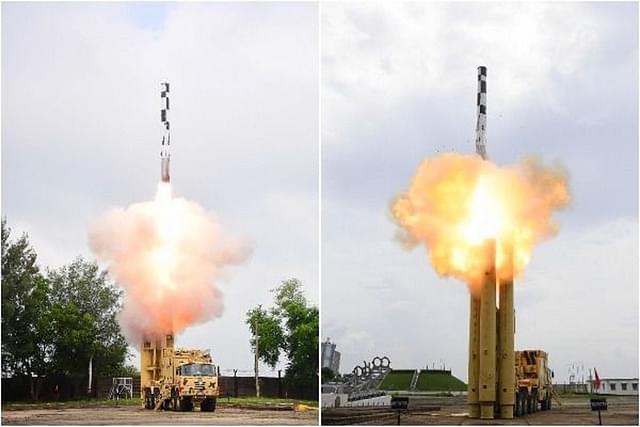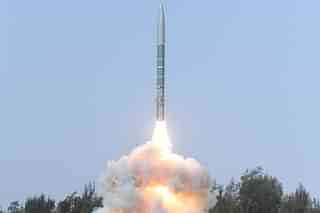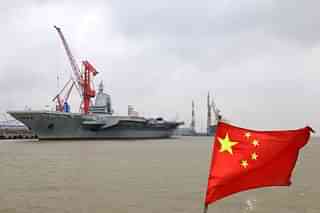World
BrahMos Delivery To Philippines: First Steps In Countering China In Its Backyard, Many More Needed
Ujjwal Shrotryia
Apr 20, 2024, 09:00 AM | Updated 01:25 PM IST
Save & read from anywhere!
Bookmark stories for easy access on any device or the Swarajya app.

Yesterday (April 19), India made a strategic move to counterbalance Chinese influence in the neighbourhood by delivering the initial batch of three BrahMos anti-ship supersonic cruise missile batteries to the Philippines Marine Corps.
It should keep up the pressure and in fact double down on the project. The deal, worth $375 million, marks India’s first export of the joint Indo-Russian cruise missile.
China is working to foment trouble for India in the neighbourhood. Take, for example, Pakistan.
It is arming Pakistan to the teeth, providing them with all kinds of weapons — including help in designing nuclear weapons and their delivery system — and exporting guided-missile frigates, diesel-electric attack submarines, fighter jets, artillery guns, rockets, and tanks. This support extends beyond military hardware to include monetary support for Pakistan’s faltering economy and diplomatic backing from the United Nations Sanctions Committee (UNSC).
Similarly, it has successfully swayed Nepal away from India by bringing a coalition of communist parties to power that seems more aligned with China. These parties have repeatedly given the impression of their unfriendliness towards India.
Nepal’s announcement of a new political map showing the Indian territory of Kalapani, Limpiyadhura, and Lipulekh as its own is a case in point.
China has also caused trouble for India in Sri Lanka by enticing Sri Lanka into a debt trap and securing ownership of the Hambantota port in southeastern Sri Lanka on a 99-year lease. The debt trap eventually forced Sri Lanka to declare default on its $51 billion debt in 2022 when the world was in the midst of the COVID-19 pandemic, and India had to provide support to Sri Lanka to the tune of $4 Billion.
More recently, in the Maldives, China was able to get a government sympathetic to their interests in power, riding on the back of an election campaign that was overtly against India.
The campaign was called 'India-Out.'
The fallout of this saw India forced to remove 90-odd serving Indian military personnel that used to service and maintain various military and surveillance assets gifted to the Maldives, apart from scraping a hydrographic survey deal with India.
In fact, just a week ago, the second batch of Indian military personnel returned to India.
The Chinese were also able to get their spy vessel to berth in Malé, which India was vehemently against. It has also tried to influence Bangladesh against India and to exercise undue influence over Myanmar’s military junta.
The export of Brahmos marks the first time that India, just like China, tried to supply strike weapons to a nation that has a territorial dispute with China, and that too in its backyard in the South China Sea (SCS).
China has maritime disputes with most of its neighbours, including the Philippines, Vietnam, Malaysia, Taiwan, and Japan in the SCS. It has for many years tried to legitimise its claims by sending militia vessels and Coast Guard ships to the territorial waters of these countries.
In the Philippines, Chinese forces are blocking the resupply of a World War II-era ship, the Sierra Madre, grounded in 1999 on the Second Thomas Shoal in the Spratly Islands. China is obstructing Philippine Coast Guard vessels from reaching the ship, often by ramming or using water cannons on supply boats.
It has also declared an air defence identification zone (ADIZ) over Taiwan and is repeatedly violating Taiwanese airspace by sending its fighter jets very close to Taiwan, other than threatening them with an invasion.
Now that the first move is made, India should not lift its foot off the pedal.
There are indications that the Philippine Army may also buy BrahMos missiles. India should expedite any such proposal from its end. Moreover, the Philippines is looking to buy 12 multi-role fighter jets (MRF) to upgrade its air force. India is offering Tejas Mk-1 jets for the project.
Although these missiles, with their Missile Technology Control Regime (MTCR) limited range of 290 kilometres won't be able to strike the Chinese mainland, they will force Chinese battleships to think twice before approaching the Philippine coastline.
India also donated the INS Kirpan, a Khukri-class missile corvette, to Vietnam, another nation which has a dispute with China over Paracel Islands, under a $500 million line-of-credit (LoC) previously extended to Vietnam. It has also exported twelve patrol boats using the $100 million LoC.
India is already training Vietnamese fighter pilots on its Sukhoi Su-30 MKI and sailors on its Russian-origin Kilo-class submarines, both of which are in service with the Vietnamese armed forces.
India also operates a satellite imaging and tracking station in Hanoi to keep track of Chinese activities, apart from signing a mutual logistics support agreement with Vietnam.
Acquisition of both the BrahMos missiles (less likely, since they already operate Russian Oniks anti-ship missiles, on which BrahMos is based) and the 50-60 kilometre range Akash-NG air defence system is also on the cards.
Expedition of all these projects and agreements is, needless to say, in Indian interests.
Furthermore, just as China maintains at least two to three spy vessels in the Indian Ocean Region (IOR) at a given time — conducting hydrographic surveys on the seabed to identify hiding spots for submarines and monitoring Indian missile launches gathering crucial data — India could also look to deploy such vessels in the South China Sea, allowing India to track and gather data on Chinese missile launches.
India's recent countermeasures indicate a potential strategy to assert its capabilities in a region that China considers its sphere of influence. In the weeks and months to come, we may well see more developments which suggest that New Delhi is capable of the same strategic manoeuvres as Beijing.
Save & read from anywhere!
Bookmark stories for easy access on any device or the Swarajya app.
Editorial Associate at Swarajya. Writes on Indian Military and Defence.
Introducing ElectionsHQ + 50 Ground Reports Project
The 2024 elections might seem easy to guess, but there are some important questions that shouldn't be missed.
Do freebies still sway voters? Do people prioritise infrastructure when voting? How will Punjab vote?
The answers to these questions provide great insights into where we, as a country, are headed in the years to come.
Swarajya is starting a project with an aim to do 50 solid ground stories and a smart commentary service on WhatsApp, a one-of-a-kind. We'd love your support during this election season.
Click below to contribute.





